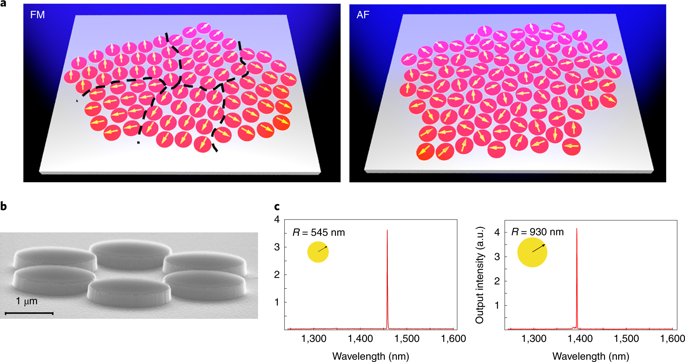Nature Materials ( IF 37.2 ) Pub Date : 2020-03-16 , DOI: 10.1038/s41563-020-0635-6 Midya Parto 1 , William Hayenga 1 , Alireza Marandi 2 , Demetrios N Christodoulides 1 , Mercedeh Khajavikhan 1, 3

|
Spin models arise in the microscopic description of magnetic materials and have been recently used to map certain classes of optimization problems involving large degrees of freedom. In this regard, various optical implementations of such Hamiltonians have been demonstrated to quickly converge to the global minimum in the energy landscape. Yet, so far, an integrated nanophotonic platform capable of emulating complex magnetic materials is still missing. Here, we show that the cooperative interplay among vectorial electromagnetic modes in coupled metallic nanolasers can be utilized to implement certain types of spin Hamiltonians. Depending on the topology/geometry of the arrays, these structures can be governed by a classical XY Hamiltonian that exhibits ferromagnetic and antiferromagnetic couplings, as well as geometrical frustration. Our results pave the way towards a scalable nanophotonic platform to study spin exchange interactions and could address a variety of optimization problems.
中文翻译:

在纳米级有源光子晶格中实现自旋哈密顿量。
自旋模型出现在磁性材料的微观描述中,并且最近已用于绘制涉及大自由度的某些优化问题的图。在这方面,已经证明了这种哈密顿量的各种光学实现方式可以迅速收敛到能量领域的全球最小值。然而,到目前为止,仍然缺少能够模拟复杂磁性材料的集成纳米光子平台。在这里,我们表明,耦合金属纳米激光中矢量电磁模之间的协同相互作用可以用于实现某些类型的自旋哈密顿量。根据阵列的拓扑/几何形状,这些结构可以由表现出铁磁和反铁磁耦合以及几何受挫的经典XY哈密顿量控制。











































 京公网安备 11010802027423号
京公网安备 11010802027423号